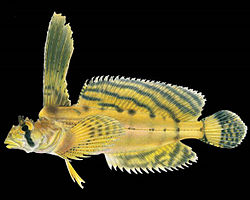
There are at least 253 identified species of fish known to inhabit the marine and brackish regions of the Salish Sea. Species are listed by common name, scientific name, typical occurrence within the Salish Seas regions. [1]
Contents
- Myxiniformes (hagfish)
- Myxinidae
- Petromyzontiformes (lampreys)
- Petromyzontidae
- Chimaeriformes (ratfish)
- Chimaeridae
- Lamniformes (mackerel sharks)
- Alopiidae (thresher sharks)
- Cetorhinidae (basking sharks)
- Lamnidae (mackerel sharks)
- Carcharhiniformes (Ground sharks)
- Scyliorhinidae (cat sharks)
- Triakidae (hound sharks)
- Carcharhinidae (requiem sharks)
- Hexanchiformes (six-gill sharks)
- Hexanchidae (cow sharks)
- Squaliformes (dogfish sharks)
- Squalidae (dogfish sharks)
- Somniosidae (sleeper sharks)
- Squatiniformes (angel sharks)
- Squatinidae
- Torpediniformes (electric rays)
- Torpedinidae
- Rajiformes (skates)
- Rajidae
- Acipenseriformes (sturgeons)
- Acipenseridae
- Anguilliformes (eels)
- Nemichthyidae (snipe eels)
- Clupeiformes (herrings)
- Engraulidae (anchovies)
- Clupeidae (herrings and sardines)
- Cypriniformes (carps)
- Cyprinidae (minnows and carps)
- Argentiniformes (marine smelts)
- Bathylagidae (deep sea smelts)
- Osmeriformes (freshwater smelts)
- Osmeridae (smelts)
- Salmoniformes (trouts)
- Salmonidae (trouts and salmons)
- Stomiiformes (dragonfishes)
- Sternoptychidae (marine hatchetfishes)
- Stomiidae (dragonfishes)
- Aulopiformes (lizardfishes)
- Synodontidae
- Alepisauridae (lancetfishes)
- Paralepididae (barracudinas)
- Myctophiformes (lanternfishes)
- Myctophidae
- Lampriformes (opahs)
- Lampridae
- Trachipteridae (ribbonfishes)
- Gadiformes (cods)
- Merlucciidae (merlucciid hakes)
- Gadidae (cods)
- Ophidiiformes (cusk-eels)
- Bythitidae (viviparous brotulas)
- Ophidiidae (cusk-eels)
- Batrachoidiformes (toadfishes)
- Batrachoididae
- Beloniformes (needlefishes)
- Scomberesocidae (sauries)
- Cyprinodontiformes (killfishes)
- Cyprinodontidae (pupfishes)
- Gasterosteiformes (sticklebacks)
- Aulorhynchidae (tubesnouts)
- Gasterosteidae (sticklebacks)
- Syngnathidae (pipefishes)
- Scorpaeniformes (mail-cheeked fishes)
- Scorpaenidae (scorpionfishes)
- Anoplopomatidae (sablefishes)
- Hexagrammidae (greenlings)
- Rhamphocottidae (grunt sculpins)
- Cottidae (sculpins)
- Hemitripteridae (spiny sculpins)
- Agonidae (poachers)
- Psychrolutidae (fathead sculpins)
- Cyclopteridae (lumpfishes)
- Liparidae (snailfishes)
- Perciformes (perches)
- Moronidae (temperate basses)
- Carangidae (jacks)
- Bramidae (pomfrets)
- Sciaenidae (drums and croakers)
- Embiotocidae (surfperches)
- Bathymasteridae (ronquils)
- Zoarcidae (eelpouts)
- Stichaeidae (pricklebacks)
- Cryptacanthodidae (wrymouths)
- Pholidae (gunnels)
- Anarhichadidae (wolffishes)
- Ptilichthyidae (quillfishes)
- Zaproridae (prowfishes)
- Scytalinidae (graveldivers)
- Trichodontidae (sandfishes)
- Ammodytidae (sand lances)
- Icosteida (ragfishes)
- Gobiesocidae (clingfishes)
- Gobiidae (gobies)
- Sphyraenidae (barracudas)
- Trichiuridae (cutlassfishes)
- Scombridae (mackerels)
- Stromateidae (butterfishes)
- Pleuronectiformes (flatfishes)
- Paralichthyidae (sand flounders)
- Pleuronectidae (righteye flounders)
- Cynoglossidae (tonguefishes)
- Tetraodontiformes (plectognaths)
- Molidae (molas)
- Notes
Salish Sea regions: JF=Strait of Juan de Fuca; SJ=San Juan Islands; BB=Bellingham Bay; SG=southern Strait of Georgia; NG=northern Strait of Georgia; NS=northern Puget Sound; SS=southern Puget Sound; HC=Hood Canal.











